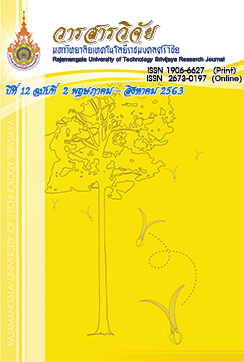Nutritional Values of Trang Indigenous Brown Rice
Keywords:
nutritional values, indigenous brown rice, healthy foodAbstract
This research aimed to evaluate physical properties, chemical properties, total phenolic content and anti-oxidant activity of indigenous brown rice in Trang province as a guideline for the development of healthy food products. Seven brown rice varieties in Trang province, which were Baoyodmong, Chomud, Huangchang, Hoysang, Nangkwit and Nangaek, were used in this research. The results indicated that each brown rice variety has different physical and chemical properties. The physical properties show color value of seven brown rice varieties as followings: L*(brightness) is between 60.81-66.08, a*(red) is between 4.78-6.19 and b*(yellow) is between 19.45-24.78. The proximate analysis such as ash, fat, moisture, protein and carbohydrate is between 1.25-1.75, 1.63-2.41, 8.60-11.83, 6.38-8.79 and 75.42-79.88, respectively. Moreover, antioxidant activity and total phenolic content of these brown rice varieties are 16.53-66.67 and 0.85-2.45 mg ferulic acid/g dry weight, respectively. Baoyodmong has the highest antioxidant activity and total phenolic content. Therefore, this brown rice variety is suitable to develop for healthy food products in the future.
References
เชาวนีพร ชีพประสพ, ฤทัยทิพย์ อโนมุณี และ หาสันต์ สาเหล็ม. 2560. องค์ประกอบทางเคมีและปริมาณอะไมโลสในข้าวพันธุ์พื้นเมือง จังหวัดพัทลุง. วารสารวิทยาศาสตร์และเทคโนโลยีราชมงคลธัญบุรี 7(2): 84-97.
นิพัทธา ชาติสุวรรณ และ วริพัสย์ อารีกุล. 2553. พารามิเตอร์สี ปริมาณฟีนอลิกทั้งหมดและปริมาณแอนโธไซยานินในข้าวสายพันธุ์ต่างๆ, น. 252-260. ใน รายงานการประชุมทางวิชาการของมหาวิทยาลัยเกษตรศาสตร์ ครั้งที่ 48.มหาวิทยาลัยเกษตรศาสตร์, กรุงเทพฯ.
ปิ่นธิดา ณ ไธสง, สุวิมล กะตากูล, จิดารัตน์ โตกมลธรรม และ ณัฐณิชา ทวีสง. 2560. การวิเคราะห์หาองค์ประกอบทางเคมีและสารต้านอนุมูลอิสระของข้าวพื้นเมืองในหมู่บ้านทิพุเย อำเภอทองผาภูมิ จังหวัดกาญจนบุรี. วารสารวิทยาศาสตร์และเทคโนโลยี 25(5): 805-812.
สมทรง โชติชื่น, อัจฉราพร ณ ลำปาง, สกุล มูลคำ, จรัญจิต เพ็งรัตน์, นิธิศ แสงอรุณ และ สำเริง แซ่ตัน. มปป. คุณค่าทางโภชนาการของข้าวพื้นเมืองไทยบางพันธุ์. กองวิจัยและพัฒนาข้าว, กรมการข้าว. แหล่งที่มา: http://WWW.Dspace.tarr.arda.or.th, 25 มิถุนายน 2563.
สัญชัย ยอดมณี. 2552. คุณภาพของข้าวพื้นเมืองมีสีภาคใต้ของประเทศไทย. วิทยานิพนธ์วิทยาศาสตรมหาบัณฑิต สาขาวิชาวิทยาศาสตร์การอาหารและโภชนาการ, มหาวิทยาลัยสงขลานครินทร์.สำราญ สมาธิ. 2560. ข้าวตรัง. ห้างหุ้นส่วนจำกัด เอส.ออฟเซ็ท กราฟฟิค ดีไซน์, กรุงเทพฯ.
อรอนงค์ นัยวิกุล. 2547. ข้าว: วิทยาศาสตร์ และเทคโนโลยี. สำนักพิมพ์มหาวิทยาลัยเกษตรศาสตร์, กรุงเทพฯ.
อัสวิน ภักฆวรรณ. 2561. ข้าวพื้นเมืองภาคใต้. เทคโนโลยีการเกษตร. แหล่งที่มา: http://WWW.technologychaoban.com, 19 มิถุนายน 2562.
Abubakar, B., Yakasai, H.M., Zawawi, N. and Ismail, M. 2018. Composition analyses of white, brown and germinated forms of popular Malaysian rice to offer insight into the growing diet-related diseases. Journal of Food and Drug Analysis 26: 706-715.
AOAC. 2000. Official methods of analysis. Association of official analytical chemist (17thed). Gaitherburg, Maryland, U.S.A.
Brand-Williams, W., Cuvelier, M.E. and Berset, C. 1995. Use of a free radical method to evaluate antioxidant activity. LWT-Food Science and Technology 28(1): 25-30.
Chooklin, S. 2013. Ultrasound-assisted extraction of phenolic compounds from brown rice and their antioxidant activities. Kasetsart Journal-Natural Science 47(6): 864-873.
Juliano, B.O. 1993. Rice in human nutrition. The Collaboration of the International Rice Research Institute Publications, Rome.
Onyeike, E.N., Olungwe, T. and Uwakwe, A.A. 1995. Effect of heat treatment and defatting on the proximate composition of some Nigerian local soup thickeners. Food Chemistry 53: 173-175.
Sawaddiwong, S., Jongjareonrak, A. and Benjakul, S. 2008. Phenolic content and antioxidant activity of germinated brown rice as affected by germination temperature and extraction solvent. KMITL Science Journal 8(2): 45-49.
Singleton, V.L., Orthofer, R. and Lamuela-Raventos, R.M. 1999. Analysis of total phenols and other oxidation substrates and antioxidants by means of Folin-Ciocalteu reagent. Method in Enzymology 299: 152-178.
Verma, D.K. and Srivastav, P.P. 2017. Proximate composition, mineral content and fatty acids analyses of aromatic and non-aromatic indian rice. Rice Science 24(1): 21-31.
Walter, M and Marchesan, E. 2011. Phenolic compound and antioxidant activity of rice. Brazilian Archives of Bilogy and Technology 54(1): 371-377.
Zubair, M.A., Rahman, M.S., Islam, M.S., Abedin, M.Z. and Sikder, M.A. 2015. A comparative study of the proximate composition of selected rice varieties in Tangail, Bangladesh. Journal Enviromental Science and Natural Resources 8(2): 97-102.
Downloads
Published
How to Cite
Issue
Section
License
The content and information in the article published in Journal of Rajamangala University of Technology Srivijaya It is the opinion and responsibility of the author of the article. The editorial journals do not need to agree. Or share any responsibility.







